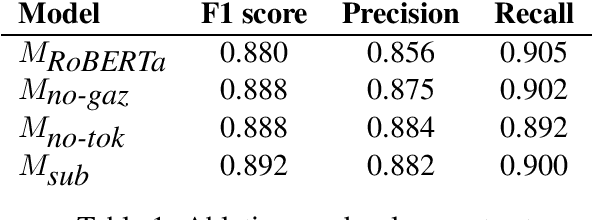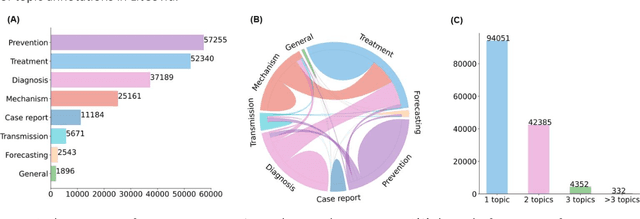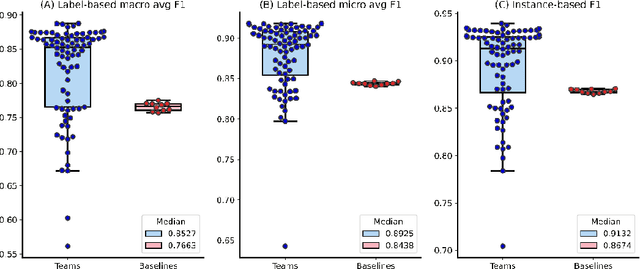Parsa Bagherzadeh
CLaCLab at SocialDisNER: Using Medical Gazetteers for Named-Entity Recognition of Disease Mentions in Spanish Tweets
Sep 13, 2022

Abstract:This paper summarizes the CLaC submission for SMM4H 2022 Task 10 which concerns the recognition of diseases mentioned in Spanish tweets. Before classifying each token, we encode each token with a transformer encoder using features from Multilingual RoBERTa Large, UMLS gazetteer, and DISTEMIST gazetteer, among others. We obtain a strict F1 score of 0.869, with competition mean of 0.675, standard deviation of 0.245, and median of 0.761.
Multi-label classification for biomedical literature: an overview of the BioCreative VII LitCovid Track for COVID-19 literature topic annotations
Apr 20, 2022



Abstract:The COVID-19 pandemic has been severely impacting global society since December 2019. Massive research has been undertaken to understand the characteristics of the virus and design vaccines and drugs. The related findings have been reported in biomedical literature at a rate of about 10,000 articles on COVID-19 per month. Such rapid growth significantly challenges manual curation and interpretation. For instance, LitCovid is a literature database of COVID-19-related articles in PubMed, which has accumulated more than 200,000 articles with millions of accesses each month by users worldwide. One primary curation task is to assign up to eight topics (e.g., Diagnosis and Treatment) to the articles in LitCovid. Despite the continuing advances in biomedical text mining methods, few have been dedicated to topic annotations in COVID-19 literature. To close the gap, we organized the BioCreative LitCovid track to call for a community effort to tackle automated topic annotation for COVID-19 literature. The BioCreative LitCovid dataset, consisting of over 30,000 articles with manually reviewed topics, was created for training and testing. It is one of the largest multilabel classification datasets in biomedical scientific literature. 19 teams worldwide participated and made 80 submissions in total. Most teams used hybrid systems based on transformers. The highest performing submissions achieved 0.8875, 0.9181, and 0.9394 for macro F1-score, micro F1-score, and instance-based F1-score, respectively. The level of participation and results demonstrate a successful track and help close the gap between dataset curation and method development. The dataset is publicly available via https://ftp.ncbi.nlm.nih.gov/pub/lu/LitCovid/biocreative/ for benchmarking and further development.
A two-stage learning method for protein-protein interaction prediction
Jul 18, 2016



Abstract:In this paper, a new method for PPI (proteinprotein interaction) prediction is proposed. In PPI prediction, a reliable and sufficient number of training samples is not available, but a large number of unlabeled samples is in hand. In the proposed method, the denoising auto encoders are employed for learning robust features. The obtained robust features are used in order to train a classifier with a better performance. The experimental results demonstrate the capabilities of the proposed method. Protein-protein interaction; Denoising auto encoder;Robust features; Unlabelled data;
Outlier absorbing based on a Bayesian approach
Jul 02, 2016



Abstract:The presence of outliers is prevalent in machine learning applications and may produce misleading results. In this paper a new method for dealing with outliers and anomal samples is proposed. To overcome the outlier issue, the proposed method combines the global and local views of the samples. By combination of these views, our algorithm performs in a robust manner. The experimental results show the capabilities of the proposed method.
 Add to Chrome
Add to Chrome Add to Firefox
Add to Firefox Add to Edge
Add to Edge